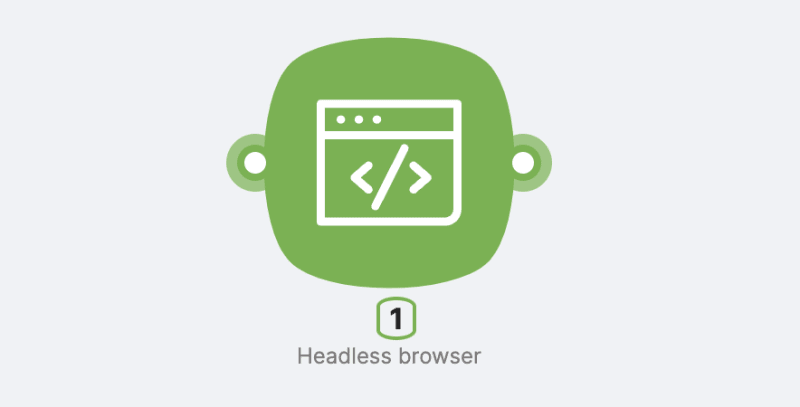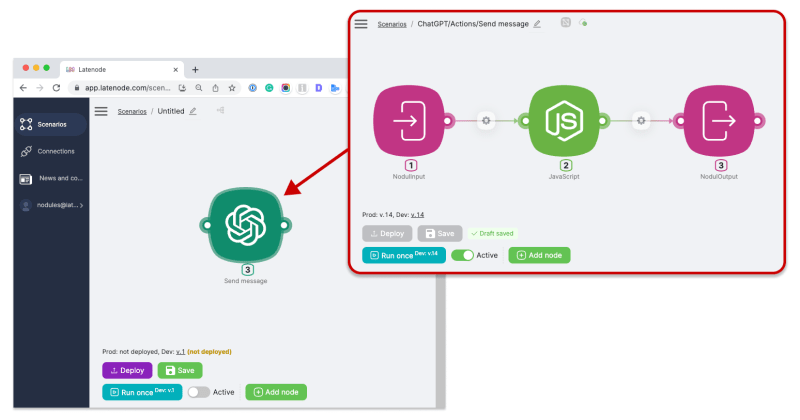Greetings DEV community! I'm Oleg Zankov, CEO of the Latenode platform. Whether we're meeting for the first time or you're familiar with our work, by the end of this article you'll gain a deeper understanding of why business automation via low-code platforms is becoming the go-to trend, and how leveraging our platform can significantly streamline your business processes and resource allocation.
Here’s a peek into the journey behind the platform's inception, its standout features, and how it stacks up against other solutions in the market.

Contents:
- Foundation History
- Key Functionality
- Comparison with Competitors
- Fair Monetization
- Conclusions
Foundation History
Latenode is our team's third significant startup, following the success of our previous projects since 2014. So, what connects these dots? Our venture into automation sprouted from these projects. We recognized the ease and efficiency of using low-code tools to craft product processes. Specifically:
- Scenarios are hosted in the cloud, eliminating the need for us to oversee the infrastructure
- Scenarios are visually represented with a straightforward "blocks" builder.
- Scenarios can be overseen by a single architect instead of a full-fledged developer team.
In our journey, 150 processes for for one of our project named Debexpert.com were eventually rolled out on the Integromat platform. But then, a twist occurred. Integromat underwent a rebranding to "Make" and transitioned to a new architecture in February 2022, with an eventual shutdown of its original version slated for September 2023
While a seamless migration to "Make" was assured, it was not delivered even a year later. This was the genesis of the Latenode platform; born out of necessity rather than just an innovative concept.
Key Functionality
Our team's experience over 9 years with various platforms (Huggin, Zapier, n8n…) has allowed us to identify what each tool missed. Integromat was a frontrunner, yet it had one shortfall – the inability to integrate custom code for enhanced architectural flexibility. When we embarked on Latenode, addressing this was our primary focus. But before we dive deeper, let's touch base on the essentials.
Event-Based Architecture
At the heart of the Latenode platform lies an event-driven architecture, designed to initiate workflows based on the foundational Trigger → Action framework.
Trigger
A trigger could be a user's interaction on a website, a newly received email, or an alert in the CRM.
We classify triggers into two categories:
- Application triggers from our ever-expanding library.
- Universal triggers not bound to specific applications.
Universal triggers encompass:
- Webhook: Enables direct data reception from various apps. When a specific event is detected in an external application, it forwards the data to the webhook URL hosted by the Latenode platform, initiating the predefined process.
-
Schedule: Launches the process adhering to a preset timetable. For instance, one can configure a scenario to be executed daily at a designated hour.

Action
Following the trigger phase is the Action segment. This addresses the query: what actions should ensue once the trigger is active? It's here that users can intuitively drag and drop application blocks, forming connections as visualized

Latenode combines the ease of no-code with the extensive functionalities associated with coding.
Our overarching goal is to democratize the creation of automations, services, and applications, relieving developers of as many repetitive tasks as feasible.
We regularly update our integration library, striving for utmost automation simplicity for users who'd rather avoid coding. And while Latenode is in its beta phase, users have access to a module that facilitates integration with diverse third-party applications autonomously.
HTTP Request
The low-code module serves as a bridge for your scenario to interface with external systems. This block enables you to query, transmit, and interact with data across different services. Typically, this interaction is facilitated by APIs that your HTTP request targets

Our HTTP block streamlines the task of configuring and dispatching these requests. Leveraging the "Create from example {CURL}" function, users can seamlessly translate CURL commands—often found in third-party app documentation—into corresponding HTTP requests. This enhances your efficiency when integrating APIs from a variety of platforms and tools
JavaScript
Introducing the JavaScript block-module-node, a feature that significantly amplifies the range of tasks you can execute on Latenode. This encompasses activities like data manipulation, data generation, and crafting versatile logic pathways.

The scope of what you can achieve here is predominantly defined by your familiarity with JavaScript. But, to be honest, it isn't just about technical prowess or experience – it's also about creativity. Within the JavaScript module, we've integrated an assistant powered by GPT-4 (akin to Github CoPilot). This assistant steps in to handle code operations once prompted with the syntax: // your textual instruction to the assistant

Moreover, our JavaScript block offers the capability to integrate NPM packages, boasting a library of over 1.3 million. Why reinvent the wheel when solutions are readily available?
Headless Browser
Ever come across the concept of headless browsers? Essentially, it's a browser that lacks a graphical user interface, and instead, robots execute commands to perform actions much like humans would
While there are startups solely focused on offering headless browser functionalities, Latenode has incorporated this feature as one of its blocks. So, it's now another tool in your arsenal, amidst the hundreds available on our platform.

For a deeper dive into the potentials of the headless browser, check out our blog post titled “Automation without APIs.”
Other Tools
Our commitment is evident in the constant enrichment of our tool library, ensuring a seamless experience for you on Latenode. A glimpse into some of our tools includes:
- Convert HTML to Text: Transform HTML content into plain text. Ideal for webpage analysis
- Convert Website to Text: Transmute an entire website into text, beneficial for SEO and content studies.
- JSON Parse: Transforms JSON strings into structured formats, perfect for API interactions.
- AI Text Parser: AI-powered text analyzer that extracts elements such as names, dates, and custom entities
Rather than just reading about it, we encourage you to explore app.latenode.com firsthand! We continually enhance our platform, introducing new tools, integrations, and augmenting the capabilities of existing ones.
Comparison with Competitors
Integromat & Make
As previously highlighted, the team behind Integromat developed a product that came closest to perfection. Still, within their community, we've noticed—and echoed—user requests that seemed to fall on deaf ears for years. Some of these suggestions lingered in the 'planned' status for extended periods, while others were seemingly bypassed. We've delved deeper into the importance of this functionality in our other write-ups.
Here are some key features we prioritized from the outset:
- Merging branches of a single scenario: This offers the capability to amalgamate multiple scenario branches into a singular module. In certain scenarios, this offers a streamlined and faster approach, while in others, it's foundational for feasibility.
- Capability to restart scenarios using historical data: This feature proves invaluable during scenario development and troubleshooting phases. It eradicates the tedium associated with manual data input post every unsuccessful run or when a pre-existing scenario stumbles upon real-world data (say, due to an external API glitch).
- Ability to craft sub-scenarios in the guise of custom modules: Imagine curating a custom toolkit, ready to be deployed in any scenario. This radically eases the process of architecting complex structures, translating to considerable time savings.

On a side note, we're on the cusp of unveiling a public library dedicated to custom blocks. This initiative not only allows creators to monetize each deployment but also empowers users to simplify their scenario development journey.
Zapier
Zapier regularly faces criticism due to its restrictive approach to process design, forcing users into a linear pattern. While they've introduced some elementary branching functions lately, it pales in comparison to intuitive drag-and-drop platforms. Their system lacks the versatility required to architect intricate designs. What's more, the absence of custom code injection considerably curtails possibilities for seasoned developers and those who desire a granular understanding of their workflows.
Cloud Functions from Amazon AWS
Cloud functionalities, represented by the likes of Amazon AWS Lambda, offer robust tools tailored for experts and major enterprises. However, there's a catch: they come with a steep learning gradient. Initial setup poses hurdles, requiring users to upload code archives, decode configurations, and more. The missing element of a user-centric interface combined with the absence of simple no-code features renders them less enticing for a significant portion of businesses
n8n
n8n emerges as a contemporary and potent player in the automation realm. Anchored in NodeJS, it resonates with a large pool of developers. In contrast, Latenode is crafted on the swift and trustworthy GoLang, epitomizing superior performance and a promising scalability horizon.
Fair Monetization
Many platforms, like Integromat, determine their pricing based on the number of operations within scenarios. Such a model can quickly become expensive, particularly when managing vast amounts of data. Consider employing an "Iterator" module to cyclically dispatch 3,000 emails in this manner:
- The iterator retrieves the email address from the database.
- Distinct email content is crafted for each receiver.
- Subsequently, the email is dispatched via platforms like Mailgun.
Cumulatively, that's 9,000 actions. If you're charged per operation, the accumulated fees can be hefty. This model inadvertently nudges scenario designers to minimize operations, often leading to efficiency compromises just to cut costs. It's much like being billed per character in a telegram dispatched via old telegraph systems (not referring to the Telegram app 🙂).
Latenode, on the other hand, introduces an innovative monetization strategy: charging for actual resource usage, including CPU time and memory utilization. Hence, the number of "blocks" or steps in your scenario becomes irrelevant. There's no pressure to abbreviate the scenario or modify its structure merely to save money. With this approach, you're only billed for what you truly consume, ensuring a supremely equitable and transparent system
At present, the platform is in its beta phase, granting complimentary access to all keen participants. Down the line, its pricing will be more economical than that of Make and Zapier.
Conclusion
To wrap up, in cultivating the low-code Latenode platform, our alignment isn't just alongside our users; we represent the very user base. For us, transitioning scenarios from Integromat to Latenode remains paramount. When we consistently encounter platform restrictions, we promptly initiate alterations to ensure no one else grapples with similar challenges
We eagerly anticipate your participation in our Discord community of low-code aficionados, where we promise to address all your queries






Top comments (0)